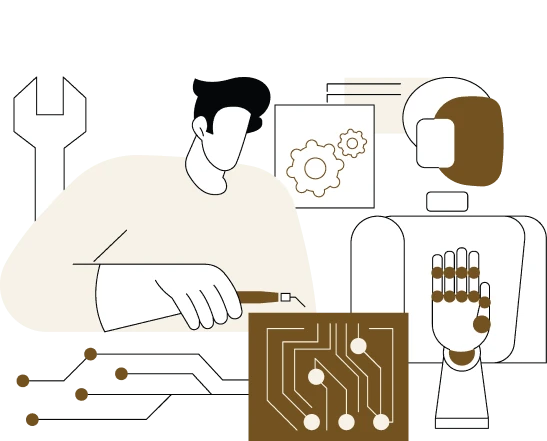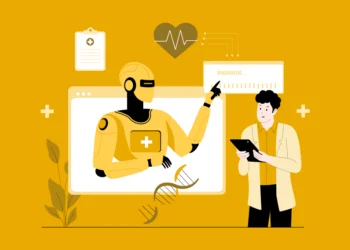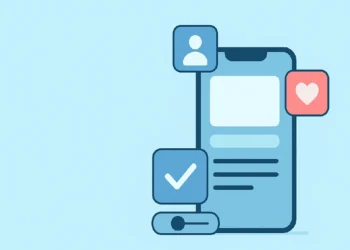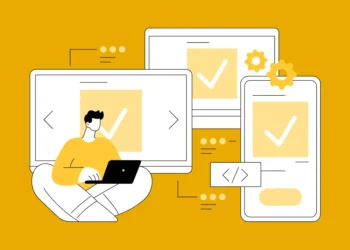- The Employee Experience AI market is set to hit an impressive $11.1 billion by 2028. This growth offers a staggering $4.4 trillion in productivity potential—a massive opportunity for businesses.
- AI improves processes from recruitment and onboarding to performance tracking and even employee retention. This demonstrates the powerful role of AI for employee engagement.
- With AI, leaders get access to real-time data. This allows for incredibly objective decision-making and helps eliminate bias.
- To truly succeed with AI in employee engagement, companies must tackle challenges. This means preparing your data, building employee trust, and addressing privacy concerns right from the start.
- The best way to introduce the role of AI in employee engagement is to position it as a collaborative tool. It’s there to augment what people do, not replace their human capabilities.
Picture this: You walk into work Monday morning, and your HR system already knows exactly what you need. It anticipated your questions, prepared your personalized training modules, and even scheduled that follow-up meeting you’ve been putting off. Sound too good to be true?
Well, this isn’t science fiction anymore—it’s happening right now in workplaces around the globe where AI in employee engagement is becoming the norm rather than the exception.
Think about it. We’re living in an era where AI for employee engagement isn’t just automating the mundane stuff (though thank goodness it’s doing that too). It’s actually understanding what makes each person tick, what motivates them, and how to keep them firing on all cylinders. And honestly? The results speak for themselves.
But here’s what’s really fascinating: while some companies are absolutely crushing it with AI in employee experience, others are still sitting on the sidelines, watching their competitors gain massive advantages. Why? Because they haven’t figured out how to harness the real benefits of AI in the workplace yet.
Let’s dive into how smart organizations are using AI and Employee experience to create workplaces that people actually want to be part of—and more importantly, how you can do the same.
Ready to boost productivity and retention?
Transform your workforce with AI-powered employee engagement solutions now
The Evolution of Employee Experience in the Age of AI – Market Dynamics
Remember when understanding how your employees felt meant waiting for those dreaded annual surveys? Yeah, those days are pretty much over. The traditional approach to gauging employee sentiment has been completely revolutionized by AI in employee experience solutions that give you real-time insights instead of outdated snapshots.
Companies like Culture Amp, Workday Peakon, and Glint aren’t just collecting data—they’re creating dynamic, living profiles of what makes each employee tick. This shift toward personalized employee experience with AI means organizations can actually respond to issues before they become problems.
And let’s talk numbers for a second. The employee experience market is absolutely exploding—we’re looking at a projected CAGR of 10.2% from 2023 to 2028, with the market hitting $11.1 billion by 2028. That’s not just growth; that’s a complete transformation of how businesses think about their people.
What’s even more impressive? McKinsey’s research shows that the AI integration in the workplace for productivity has the potential to add $4.4 trillion in productivity growth over the long term. When you see figures like that, it becomes crystal clear why forward-thinking companies are doubling down on AI employee experience initiatives.
These aren’t just operational improvements we’re talking about—this is about fundamentally changing how organizations connect with and empower their workforce.
How AI Is Enhancing Every Stage of the Employee Journey from Recruitment to Retention
Here’s where things get really interesting. AI in employee engagement isn’t just touching one part of the employee lifecycle—it’s transforming everything from the moment someone applies to work with you until the day they retire (hopefully many years later).
Let me walk you through how this actually works in practice:

Recruitment: Finding the Right Fit, Faster
AI for employee experience starts before someone even becomes an employee. AI in the HR recruitment process analyzes job descriptions and candidate profiles with a precision that would make even the most experienced HR professional jealous. These systems don’t just match skills—they predict cultural fit and long-term potential.
Real-life Example:
Take Talentech’s AI-powered Applicant Tracking System (ATS). It’s not just screening resumes; it’s creating a personalized employee experience with AI from the very first interaction. The result? Faster hiring, better matches, and candidates who actually stick around.
Onboarding: Setting the Stage for Success
We’ve all been through terrible onboarding experiences—those first days where you’re drowning in paperwork and wondering if you made the right choice. AI tools for employee engagement are changing that completely.
Real-life Example:
SC Training (formerly EdApp) has cracked the code on this. Their platform uses AI for employee training to create personalized learning journeys that adapt to how each person learns best. No more one-size-fits-all training modules that put everyone to sleep.
Performance: Real-Time Insights, Real Results
Traditional performance reviews? They’re becoming as outdated as fax machines. AI in employee engagement now provides continuous, objective feedback based on actual data rather than someone’s subjective opinion from six months ago.
Real-life Example:
Betterworks exemplifies this perfectly. Their platform demonstrates excellent examples of AI in the workplace by providing real-time feedback, goal-setting tools, and alignment with company objectives. Managers get actionable insights, employees get timely guidance, and everyone wins.
Retention: Keeping Your Best People
This is where AI tools for employee engagement really shine. Instead of waiting until someone hands in their resignation letter, AI can spot the warning signs weeks or even months in advance.
Real-life Example:
The 15Five approach to boosting employee productivity with AI includes sophisticated sentiment analysis that tracks communication patterns and engagement levels. When the system detects early signs of burnout or disengagement, HR teams can intervene before it’s too late.
Key Use Cases of AI in Employee Engagement
Let’s get practical for a moment. What does the role of AI in employee engagement actually look like day-to-day? Here are the areas where organizations are seeing the biggest impact:
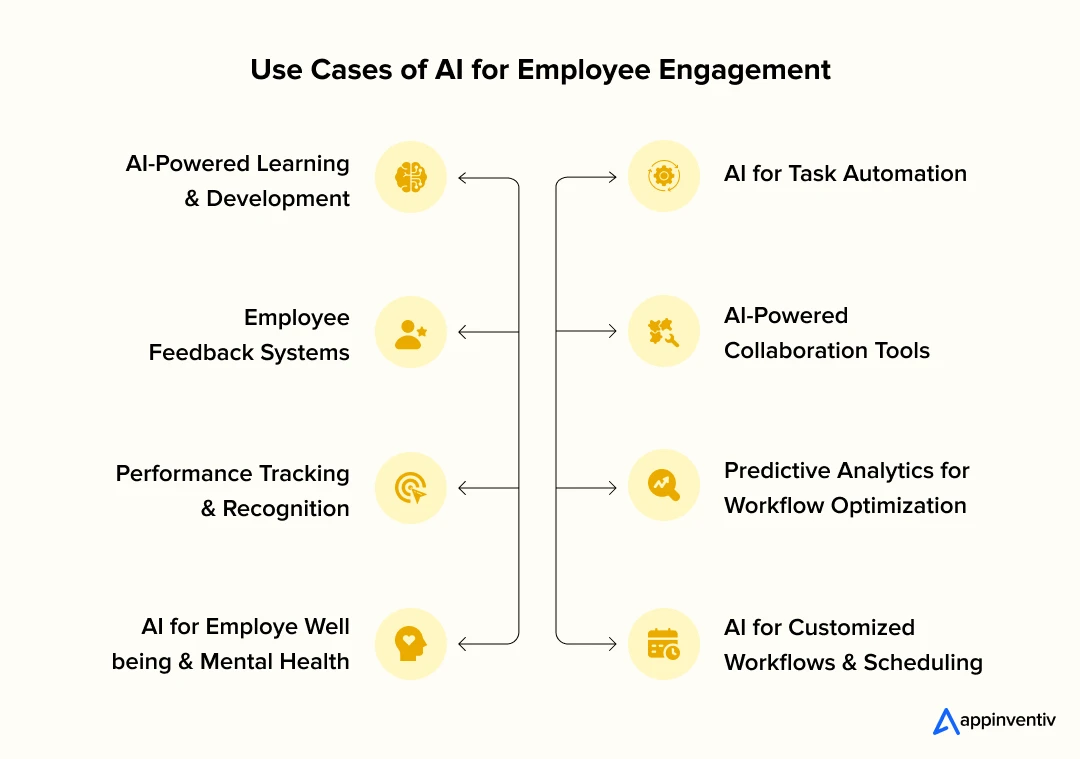
AI-Powered Learning and Development
Traditional training approaches often feel like shooting in the dark—you create content and hope it sticks. AI for employee training takes a completely different approach by personalizing learning experiences based on individual learning styles, progress, and career goals. AI-driven learning platforms deliver adaptive e-learning content that keeps employees engaged and challenged.
The beauty of generative AI and employee experience in learning is that it doesn’t just deliver content—it creates content tailored to each person’s needs. Someone struggling with a concept gets additional practice materials automatically generated, while fast learners get advanced challenges to keep them engaged.
Employee Feedback Systems: Beyond the Annual Survey
Here’s one of the most powerful examples of AI in the workplace: continuous feedback systems that replace those dreaded annual surveys with ongoing, natural conversations. AI tools for employee engagement can analyze everything from Slack messages to email patterns to gauge sentiment in real-time.
The best part? Employees don’t feel like they’re being monitored—they feel heard. The system picks up on subtle cues that might indicate stress, excitement, or disengagement, allowing managers to respond appropriately.
Performance Tracking and Recognition
Remember when performance reviews were based on whoever spoke up loudest in meetings? AI in employee experience systems tracks actual contributions, collaboration patterns, and goal achievement to provide objective performance insights.
This shift toward data-driven performance management represents one of the most significant benefits of AI in the workplace—it eliminates bias and ensures everyone gets recognized for their actual contributions.
AI for Employee Well-being and Mental Health
This is one of the most important applications of AI in employee experience. These tools help maintain employee mental health, monitor stress indicators, workload patterns, and communication changes to identify employees who might be struggling before they reach a breaking point.
It’s not about invading privacy—it’s about creating early warning systems that help organizations support their staff proactively.
Task Automation: Freeing People for What Matters
Let’s be honest—nobody got into their career to spend hours on data entry or scheduling meetings. AI integration in the workplace excels at handling these repetitive tasks, freeing up employees to focus on work that actually energizes them.
This represents a fundamental shift in how we think about productivity. Instead of making people more efficient at boring tasks, we’re eliminating those tasks entirely.
Collaboration Tools That Actually Help
How many collaboration tools have you used that promised to streamline teamwork but ended up creating more work instead? AI tools for employee productivity are different because they learn from how teams actually work together and adapt accordingly.
These systems don’t just organize information—they anticipate needs, suggest optimizations, and remove friction from collaborative processes.
Predictive Analytics for Workflow Optimization
One of the most exciting applications of boosting employee productivity with AI involves predicting and preventing problems before they occur. Instead of reacting to problems, teams can stay ahead of them. AI uses predictive analytics to forecast potential bottlenecks, identify productivity trends, and suggest proactive solutions to streamline workflows. This helps teams respond to changing demands and maintain optimal productivity levels.
AI for Customized Workflows and Scheduling
Everyone has different peak performance times and working styles. AI in employee engagement systems can analyze individual productivity patterns and create customized schedules that maximize both output and satisfaction.
This personalization extends beyond just scheduling—it includes workspace preferences, communication styles, and collaboration patterns.
How AI Elevates Leadership and Management for a Better Employee Experience
Leadership in the age of AI looks fundamentally different from traditional management approaches. Employee experience and AI convergence are empowering leaders with unprecedented insights into their teams’ needs, motivations, and potential.
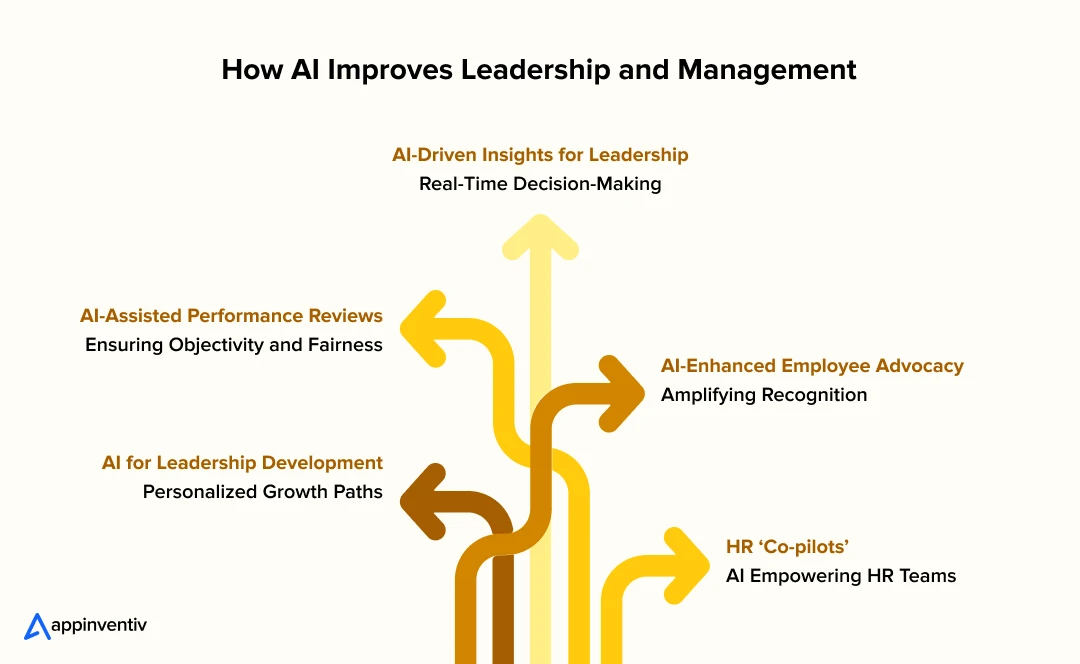
AI-Driven Insights for Leadership: Real-Time Decision-Making
The days of managing by gut feeling are rapidly disappearing. AI in employee experience provides leaders with real-time data about team dynamics, individual performance trends, and emerging challenges.
These insights enable proactive leadership rather than reactive management. When AI detects that a team member’s engagement is declining, leaders can address the issue before it impacts performance or spreads to other team members.
AI-Assisted Performance Reviews: Ensuring Objectivity and Fairness
Traditional performance reviews often reflect managerial bias more than actual performance. AI for employee engagement systems eliminates this by tracking objective metrics and providing comprehensive performance pictures based on actual data.
This objectivity doesn’t make reviews less human—it makes them more fair and actionable.
AI-Enhanced Employee Advocacy: Amplifying Recognition
Some of the best employees are also the quietest. Generative AI and employee experience platforms ensure that contributions from introverted team members or those in support roles get the recognition they deserve.
By analyzing communication patterns, project contributions, and peer interactions, AI can identify unsung heroes and ensure their efforts are acknowledged.
AI for Leadership Development: Personalized Growth Paths
Leadership development programs traditionally take a one-size-fits-all approach. AI employee experience systems can identify individual leadership strengths and development areas, creating personalized growth paths for managers.
HR ‘Co-pilots’: AI Empowering HR Teams
HR professionals are getting their own ‘Co-pilots’ are AI-driven assistants that help streamline workflows, provide data-driven insights, and automate routine tasks. These benefits of AI in the workplace allow HR teams to focus on strategic initiatives rather than administrative busywork.
Overcoming Barriers to AI Adoption for Employee Engagement: Addressing Privacy, Ethics, and Trust Issues
Let’s address the elephant in the room. While the impact of AI in employee experience is largely positive, organizations face legitimate challenges when implementing these systems.
Key Challenges in AI Adoption for Employee Experience
Lack of AI-Ready Data:
Gartner’s research shows that 61% of organizations are scrambling to evolve their data infrastructures because of AI technologies. Without clean, structured data, even the most sophisticated AI-powered employee engagement systems can’t deliver accurate insights.
Employee Resistance and Stress:
Here’s a sobering statistic: 66% of workers worry that AI could lead to job displacement and increased workload stress. These concerns aren’t unfounded—they’re natural responses to technological change that organizations must address head-on.
Data Privacy and Security Concerns:
As AI integration in the workplace becomes more sophisticated, privacy concerns intensify. Employees need assurance that their personal data is protected and used ethically.
Also Read: AI Regulation and Compliance in the US
AI Bias:
Algorithmic bias can perpetuate or even amplify existing workplace inequalities. Organizations must invest in AI solutions designed to minimize bias and promote fairness.
Lack of Trust in AI Systems:
Many employees fear that AI operates as a “black box” that makes decisions they can’t understand or challenge. Building trust requires transparency and clear communication about how AI systems work, like the ethical AI approach.
Solutions to Overcome AI Adoption Challenges
Training and Upskilling Employees:
The most effective way to address AI anxiety is through education. Comprehensive training programs help employees understand how to work alongside AI systems rather than compete with them.
Building Trust with Ethical AI Policies
Transparent AI policies that prioritize fairness, accountability, and employee privacy are essential for successful adoption.
Strengthening Data Foundations
Successful AI implementation requires investment in data governance, ensuring that systems have access to accurate, relevant, and secure information.
Human-AI Synergy
The goal isn’t to replace human judgment but to enhance it. AI in employee engagement works best when it amplifies human capabilities rather than trying to replace them.
Ready to Build Your AI Employee Engagement Platform?
Join companies like JobGet that achieve 40% higher productivity and 30% better retention with custom AI solutions.
How Appinventiv Helped JobGet Build an AI-Powered Recruitment Platform and Achieve a Funding of $52 Million
Here’s a real-world example of AI in employee experience success. JobGet approached Appinventiv with a common problem: their recruitment process was too slow and too manual, resulting in poor matches and frustrated candidates.
We implemented an AI-powered recruitment platform that used machine learning and natural language processing to match candidates with roles based on skills, experience, and preferences. The results? A 40% reduction in hiring time, 30% improvement in matching accuracy, and a dramatically better candidate experience.
This success story demonstrates how the right approach to AI for employee experience can transform not just internal operations but also business outcomes.

Partner with Appinventiv for AI-Driven Solution Development
The transformation of workplace dynamics through AI in employee engagement is no longer a future possibility—it’s happening right now. Organizations that embrace this change are creating more engaged workforces, higher productivity levels, and better business outcomes.
But here’s the thing: successful AI implementation isn’t just about choosing the right technology. It requires a deep understanding of both AI capabilities and human workplace dynamics. That’s where choosing the right development partner becomes crucial.
Appinventiv brings over a decade of experience in delivering next-generation AI development services that actually work in real-world workplace environments. Our team of 1600+ professionals understands that AI in employee experience initiatives succeeds when it enhances human potential rather than replaces it.
We’ve earned recognition as Deloitte’s Fastest-Growing Company 2025 and Clutch’s Top Android & Chatbot Development Company 2025, but what we’re most proud of is helping organizations create smarter, more engaged workforces.
Whether you are just beginning to explore AI in employee experience possibilities or you are ready to implement comprehensive solutions, our AI consulting services can help you navigate the technical complexities while ensuring your people remain at the center of everything you do.
Ready to integrate AI into your employee experience strategy? Contact us today for a tailored consultation and discover how we can help you build a smarter, more engaged workforce.
FAQs
Q. What are real-world examples of AI enhancing workplace productivity?
A. AI is making a significant impact on workplace productivity by automating tasks and streamlining processes. Some real-world examples include:
- AI-Powered Automation: Companies like UiPath and Automation Anywhere use AI to automate repetitive tasks such as data entry, invoice processing, and customer support. What this does is free up employees; they can then spend their time on higher-level, more valuable activities.
- AI in Project Management: Tools like Monday.com and Trello’s Butler use AI to prioritize tasks, assign roles, and track progress, ensuring teams stay aligned and deadlines are met more efficiently.
- Predictive Analytics: Salesforce Einstein and Microsoft Dynamics use AI to predict sales trends, optimize workflows, and allocate resources effectively. The results? Employees spend less time on administrative tasks and more time on impactful work.
Q. What’s the future of AI in workplace culture and team collaboration?
A. The future of AI in workplace culture and collaboration is shifting towards creating dynamic, adaptable environments that continuously evolve based on real-time data and employee behaviors. Here’s how AI could transform workplace collaboration:
- AI-Driven Dynamic Team Formation: Imagine AI analyzing a project’s requirements and dynamically assembling a team by matching people’s expertise and collaboration preferences. This would ensure the right talent is working together at precisely the right moment, with hardly any manual setup.
- Cognitive Collaboration Tools: We’re going beyond just simple chatbots. AI will evolve into cognitive collaboration assistants that can predict the outcome of different team interactions, suggest improvement areas, and facilitate communication between team members, regardless of geographic location. These systems will track team dynamics, helping managers proactively adjust workflows or resolve conflicts before they escalate.
- AI-Powered Collaboration Hubs: Virtual collaboration environments will be fully AI-integrated, with AI systems that analyze ongoing conversations, tasks, and deadlines to create automated workflows that guide team members step-by-step. These smart hubs will learn from team interactions and continuously improve, suggesting optimal ways for teams to work together and share information seamlessly.
- Emotion-Aware AI: Future AI systems will gain the ability to track team sentiment. They’ll alert leaders to potential interpersonal issues or stress factors within the group. Based on this emotional data, AI could recommend specific actions to improve team morale, such as offering rest periods or reshuffling responsibilities.
- AI-Enhanced Diversity and Inclusion: As diversity and inclusion remain a top priority for organizations, AI will be used to assess cultural fit and team diversity. AI will evaluate team performance data alongside individual backgrounds to identify biases, recommend more diverse hiring practices, and even suggest inclusive communication strategies, ensuring that teams are both high-performing and inclusive.
Q. How can AI be used for employee engagement?
A. AI helps create a more engaging workplace by offering tools that understand and respond to employee needs.
- It processes data like performance metrics and feedback to spot trends, letting managers tackle issues like low morale early.
- AI-powered systems deliver fair, bias-free performance reviews by focusing on clear metrics, which builds trust.
- They also highlight employee achievements, ensuring everyone gets recognized, boosting team spirit.
- Plus, AI crafts personalized growth plans for employees and leaders, keeping motivation high.
- HR ‘co-pilots’ handle repetitive tasks like onboarding or wellness checks, so HR teams can focus on meaningful engagement strategies.
This fosters a supportive, open culture that improves satisfaction and keeps employees invested.
Q. What role does sentiment analysis play in employee experience platforms?
A. Sentiment analysis plays a critical role in enhancing employee experience by providing deep insights into employee emotions, engagement levels, and workplace dynamics in real-time. Here’s how it helps:
- Reads the Room: Checks emails, chats, or feedback to sense how employees are feeling, like stressed or motivated.
- Catches Problems Early: Notices subtle changes in tone that signal disengagement, helping managers step in quickly.
- Tailors Support: Guides personalized feedback or praise based on what employees seem to need most.
- Shapes Better Communication: Helps leaders tweak how they talk to teams, building stronger trust.
- Boosts Team Spirit: Pinpoints what employees care about, shaping ideas to lift morale and connection.
Q. How can AI detect employee burnout or disengagement?
A. AI uses predictive models and real-time behavioral analysis to detect early signs of burnout and disengagement. Let’s see how:
- Checks work patterns, like long hours or slow task completion, to spot fatigue.
- Analyzes email or chat tone for signs of stress or low morale.
- Tracks participation in team activities or surveys to notice dips in engagement.
- Alerts managers early, helping them offer support or adjust workloads.
Q. What are the challenges of using AI in employee engagement?
A. Bringing AI into the realm of employee engagement definitely comes with specific challenges. These need careful attention for successful integration:
Privacy Worries: Staff may feel uneasy about AI tracking their data, so clear rules are needed to gain trust.
Tech Overload: Relying too much on AI insights can weaken personal connections between managers and teams.
Flawed Algorithms: AI trained on bad data might give unfair or off-base suggestions, impacting decisions.
Pushback from Employees: Some may resist AI tools, feeling watched or less in control of their work.
High Costs: Setting up AI systems takes money for tech, training, and setup, which can be tough for budgets.


